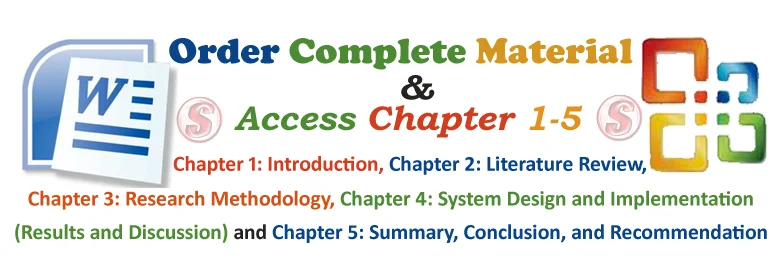1.0 Introduction
1.1 Background of the Study
The traditional contract theory has ensured that a contract should contain the agreement that would deal specifically with all expected incident which may or may not occur in the future in the course of managing the execution of the building project. If the parties to the contract intend therefore to contend and contain all agreement for uncertain situation in one simple document “the contract”, the contract document would likely become extremely complex. This is why the construction contract is regarded as “incomplete” contracts which do not provide specific responses for all contingencies but is based on the rule of “risk sharing”.
Collectively therefore, construction contract projects cover many errors that can be broken down into the process of construction of building, bridges, roads and the likes, and an agreement arrangement that is legally binding on the parties to it, that if broken, may be enforced by action in court against the defaulting party. In this regard therefore, a contracting party is bound because he has agreed to be so bound. Furthermore, such an agreement must be intended to create and be capable of affecting legal relations in order to be able to give risk to a contract.
These are relevant ingredient in the construction of building contract and do contain the provisions as to how to deal specifically with all expected incidents when they arise. This means that construction contract must entail “project cycle” management from inception, that is pre-contract stage to execution and completion and others grouped under post contract stage to execution and completion.
Sidney (1980) defines variation as; this involves variation through the processes of Architects Instruction (AI'S), valuation of fluctuation of claims that result from the architect's instruction, where who gets what from who is ascertained. This is made possible when the contract duration spend twelve months and more and fluctuation clause form part of the contract term.
In order to cope with the experience of the variations order, therefore the impact and management of variations and fluctuation in construction contract project becomes on “since fuo non” to maintaining a cordial relationship between the client and the contractor and even the other professionals engaged in the same project execution. Nwachukwu (1991).
1.2 Statement of the Problem
The construction industry in Nigeria is import dependent with various economic measures introduced by the government that directly and indirectly result in constant and rapid “upward” price changes for the principal construction “imported” material like cement reinforcement steel bars and the likes.
Those manufactured locally, such as ceramic tiles, asbastos ceiling sheets to mention but a few equally have foreign input in terms of foreign exchange rate and import duties related problems and even value added tax (VAT) on them.
It is therefore essential that provisions be made for the construction of building project that span twelve months and more to incorporate the fluctuation clause; that is, clause 31A to F of the federal ministry of works and housing otherwise called GC/WORKS/FORM EDIITON, where the parties have agreed to fluctuation of cost sand whose contract sum shall be deemed to have been calculated in the manner set out in the appropriate manner subject to variations in the event specified in.
The rules in the schedules of rate being based upon the rates of wages and other emoluments and expenses (including the cost of employers liability insurance and third party insurance) payable by the contractor to the work people engaged upon or in connection with the works in accordance with the rates of wages fixed by the federation of building and civil engineering construction current at the date of feder and applicable to the area concerned.
“All these point to one thins, how to put the ever increasing cost of construction of building in check and when it occurs, how the risk is shared between the client and the contractor.
1.3 Purpose of the Study
The purpose of this research work is to investigate the endemic construction of building contract projects delays, its rising cost and abandonment in Imo state Nigeria.
1.4 Objectives of the Study
The objectives of this research works are:
- To ensure that adequate time and care are allocated to tender examination and tender analysis
- To ensure that the contractor is handed all necessary information to carry out the construction of the building as soon as the contract is placed.
- To ensure that the contractor realize that the Architect is empowered by the conditions that constitute variation and fluctuations.
- To determine why the architect should settle the dates of possession of the site and completion of work with the contractor at the on-set.
1.5 Research Question
At the end of this study answers will be preferred for the following questions;
- What is the major effect of variation in construction contract project?
- What is the relationship between fluctuations and the contract sum?
- Can fluctuation be controlled in construction contract projects?
- What is role of the quantity surveyor in managing the effects of variation and fluctuations on construction contract projects as it concerns the client and the contractor?
1.6 Significance of the Study
The beneficiaries of this research work are, the contractors the clients who are placed in position not to bear the burden of risk inherent in variation and fluctuations, that is, increase in costs which most often than not cumulate to time and costs overruns. These on the long run lead to abandonment of building projects.
The economy at large will also benefit in the sense that less abandoned projects would dot the streets and employment sustained for that various professionals and skill and unskilled hands engaged in the industry.
1.7 Scope of the Study
The scope of this research covers the importance of managing variation and fluctuations in the building industry as well as the impact. It also examines the relevant clauses that deal with variation and fluctuation in the building industry in Nigeria (Imo) with particular reference to vital requirement that states “No variation shall vitiate the contract”. This is an essential clause that protects the parties in the building and similar construction contract projects on the face of the rules of contract law; where variation orders means introduction of new elements into the contract that would have ordinarily meant a breach for which the contractor may determine the contract and claim damages.
Furthermore, “The standard form of contract for Building project ICT” so Edition Private without quantities” clause 13.1 has far reaching effect in variation under;
- Circumstances that would not have been reasonably fore seen before placing the contract.
- Additional requirement of the employers
- Compliance with new government order or legislation.
- Correction of errors or omissions in the contract drawing and contract bills.
- Non-availability of materials and goods and workmanship specified in the contract.
- Substitution of materials and goods and workmanship specified in the contract.
1.8 Limitation of the Study
This research work is limited to effect of variation and fluctuations and in the construction of building contract projects under:
- Contract sum
- Contract time
- Aviodance of costly errors and decisions
- Builders resources
- False fuantum of saving
- Builders financial burdens
- Clients nightmare
The limiting factor is length of time construction of building projects take to be completed which usually spans twelve months or more. This places a burden of care on the contractor to build within the clients available resources, which in most cases is not feasible during the long period of the execution of the contract. The major problems I encountered in the course of this study are;
A. Inadequate Time:
There was no adequate time to carry out more extensive and detailed research. The one month given for this work is grossly inadequate to cover the study.
B. Material Constraint:
There is lack of material to make more detailed research and the few available ones on “net” were not accessible as subscriptions were demanded.
C. Inadequate Resources:
The general economic melt-down placed a heavy burden on the loan resources at my disposal.
1.9 Organization of the Work
This work in five chapters as; chapter one deals with the introduction, chapter two is the literature review and chapter three deals with the research methodology. Data presentation and analysis is dealt with in chapter four while chapter five covers the summary, conclusion and recommendation.
1.10 Definition of Terms
Before going further to illustrate the effects and management of variation of building industry, it is important to have a brief definition of some key words that features in this research study;
Date of Tender:
This means the data that is fixed for the receipt of the tender by the employers it is usually ten(10) days before the receipt of tender.
Contract Sum:
This is the sum that cannot be adjusted or altered in any way whatsoever, otherwise then in accordance with the express provision of the conditions of contract and subject to clause 2.2 of the JCT'S edition, that stipulates that, any error whether of Arithemetic or not in the accepted by the parties hereto. JCT 80 14.2.
Architects Instructions:
These are the empowering instructions in the conditions of contract JCT 80 edition clause 401-4.3.2 that he (the contractor) may make reasonable objective in writing to the architect to such compliance. All architects instruction (A.I.S) must be made in writing or confined within 5 working days if given orally. They constitute variations.




